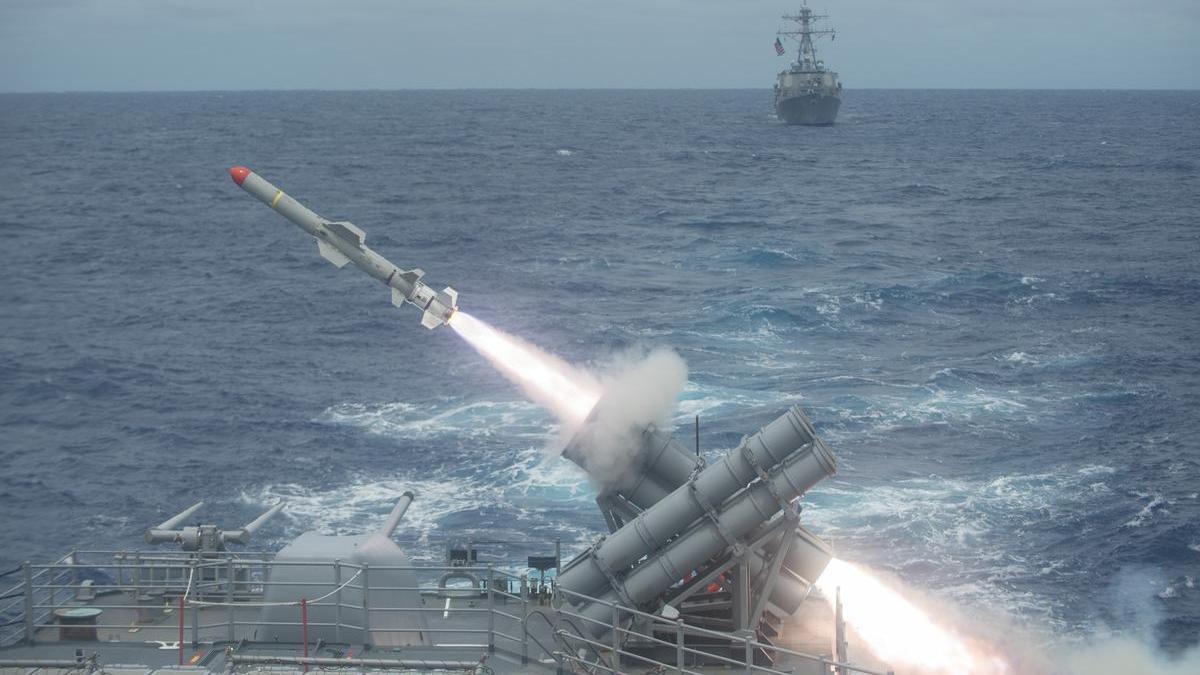They are expensive but very effective missiles to sink ships. It is believed that they were used against the Moskva, the flagship of the Crimean fleet.
Five individual Harpoon AGM-84 anti-ship missiles have already arrived at Ukraine from Spain, according to Oryx weapons trackers who keep an accurate list of weapons sent to the country invaded by Russia. Are powerful naval missiles costing around a million euros per unit. It is estimated that, with a dozen of them, Ukraine could damage the Russian Black Sea fleet. Russia maintains about 20 warships in Crimea. Several analysts have pointed to these missiles as the cause of the sinking of the Russian flagship Moskva at the beginning of the war. The Ministry of Defense, contacted by this newspaper, has declined to comment because they do not talk about this type of shipment.
The United States, Denmark, the Netherlands, the United Kingdom have delivered units of these missiles. Spain would have joined now, according to Oryx. These missiles can be used to destroy ships from the air, from land or from the sea. In the case of Spain, they are planned to be launched from frigates, as explained by knowledgeable sources. But its use could be different in Ukraine. The Russian Army has been seen using S-300 air defense missiles to destroy ground targets, for example.
Harpoons are missiles very expensive, but also very effective. Like all the advanced weapons that are being sent to the country, requires training, which can last several weeks. In principle, Ukraine would already have soldiers trained to handle them after the first shipments of the summer.
Denmark promised to send Ukraine a launcher and several Harpoon missiles, US Defense Secretary Lloyd Austin announced on May 24. A few days earlier it was learned that the White House was preparing a plan to deliver these powerful missiles to the Ukrainian Armed Forces, probably through a third country. Everything is done with great discretion because the sinking of Russian fleet ships can be seen from Moscow as an escalation in the conflict. On April 14, Ukraine sank the missile carrier Moskva, the flagship of the Black Sea Fleet. Was a military coup, but also a blow to morale of the Russian invader.
“The Harpoon missile is an American subsonic anti-ship missile that has been in service since the mid-1970s and that, since then, has been updated and has been adopted by a large part of the NATO member states,” Beatriz explained to this newspaper. Cózar Murillo, doctoral candidate in Strategic Studies and author in the Ejércitos Magazine. “In the specific case of the missiles that Denmark plans to send to Ukraine, it is an adaptation of this system designed so that the missiles can be launched from a truck carrying a mount for four missiles. The detection and control systems are mounted on other trucks”.
One or two dozen such Harpoon-like missiles, with ranges of more than 100 km, could be enough to threaten Russian ships blockading the Ukrainian coast, Hudson Institute naval expert Bryan Clark says.
Characteristics
There are several models of the Harpoon missiles. Although the Harpoon model planned to be sent to Ukraine has not been specified, the Danish Navy is known to have batteries of Harpoon Block II missiles, manufactured in Saint Charles, Missouri by the US company Boeing Integrated Defense Systems. Specifically, the Danish model is the RGM-84L-4, which is capable of hitting targets at 280 km.
They weigh between 519 and 628 kg and measure between 3.8 and 4.6m, depending on the launch platform. They carry a head of about 250 kg, with penetrator explosive. Propulsion is achieved by an engine called Teledyne Turbojet that uses solid fuel. The speed is 0.85 times that of sound; that is, they fly at 281 meters per second.
More than loose missiles, the Harpoon is a “coastal defense system” consisting of three modules that can be attached to different types of trucks or tractors: a missile control unit, two launch/transport units (with four ‘canisters’ that stand up to fire) and a launcher replenishment unit (which are transferred to the launch area by crane).
“The missile control unit is the only manned vehicle and is the heart of the launch system. It is operated by a minimum of three people and contains the weapons control console, a launcher switching unit, a training module and communication transceivers”, analyzes an arms expert from the Security Hub consultancy who prefers to remain anonymous. “The Harpoon is one of the best and most versatile missiles out there, but there are several models: one for the US and another for export, which is usually inferior in characteristics”, concludes the expert.
The missile uses GPS assisted by an inertial navigation system to hit its designated target. One of the characteristics of the version in possession of Denmark of the Harpoon is that they can hit the target even against ships very close to land.
Russia has an almost total presence in two Ukrainian seas: Azov, already fully controlled by the invading army, after taking the port city of Mariupol; and the Black Sea. The latter bathes the coasts of Crimea, where Russia has the maritime base of Sevastopol.
